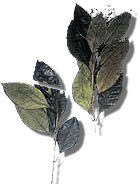| DESCRIPTION: Often a bushy shrub or a small tree up to 10 m in height, but it may be much larger, occasionally reaching 40 m. Bark light grey, becoming dark grey and vertically fissured with age. Leaves lanceolate-oblong to almost circular, 3-10 x 1.5-5 cm, light to dark green and glossy above, rather paler green below. Fruit ovoid, fleshy, up to 2 x 1 cm, when ripe they are somewhat succulent purplish drupes. This species has been divided into 3 subspecies: ssp. macrocarpa, fruits oblong to elliptic, up to 2 x 1 cm; flowers in lax heads. Ssp. capensis, fruits almost spherical to oblong elliptic, up to 1 cm long; flowers in dense heads and leaves very variable, apex often rounded; branchlets grey to greyish-brown. Ssp. enervis, leaves usually broadly elliptic, apex tapering; branchlets grey to whitish. USE: It produces high quality timber. It has dark brown heartwood and is attractively figured, fine-grained, hard and heavy and although it is difficult to work it has been widely used in railway sleepers, wagon woods, bridge construction and for flooring blocks. It can also produce beautiful furniture. The wood is also used as firewood and charcoal. It is a useful fodder tree. GROWING PERIOD: Perennial. COMMON NAMES: Black ironwood, Elgon olive. FURTHER INF: It occurs almost throughout Africa south of the Sahara desert from Sudan and Ethiopia to the southern extremity of the continent and west to the Islands of the Gulf of Guinea and to Sierra Leone. Occurring in bush, littoral scrub and evergreen forest in situations where temperatures are relatively low and, apart from diurnal fluctuations, fairly constant temperatures throughout the year. In East Africa, the elevations where the tree naturally grows provide these conditions, and further south in the range it occurs at lower elevations but at these latitudes temperatures are also lower. |
